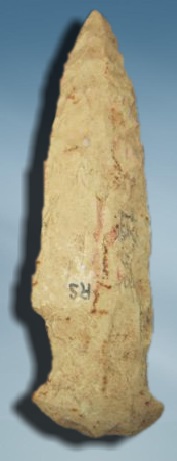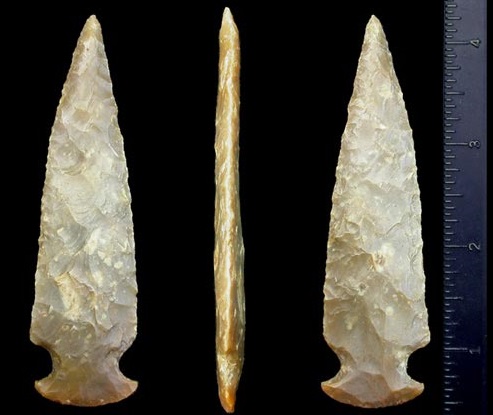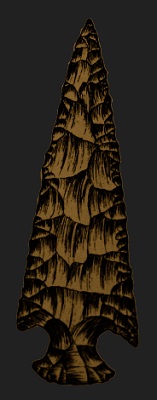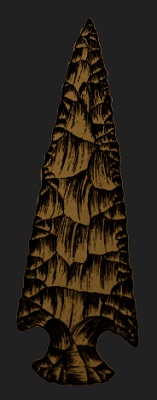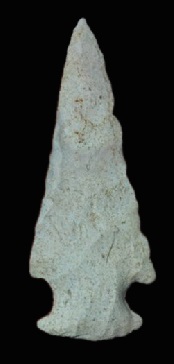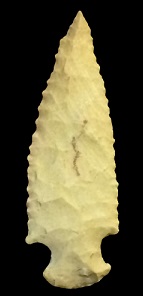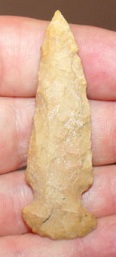Outline is Representative of Size and Shape:

Name Details:
Identified By: David A. Baerreis and Joan E. Freeman
Named For:
Date Identified: 1959
Type Site: Bluff Shelter Site, Ponotoc County, Oklahoma
Identified By: David A. Baerreis and Joan E. Freeman
Named For:
Date Identified: 1959
Type Site: Bluff Shelter Site, Ponotoc County, Oklahoma
Point Validity:
Valid type
Baerris is a well published anthropologist and was a professor at the University of Wisconsin-Madison. Freeman is an anthropologist and conducted extensive studies on North Carolina archaeology. This type was named in a professional publication and is considered a valid type.
Baerris is a well published anthropologist and was a professor at the University of Wisconsin-Madison. Freeman is an anthropologist and conducted extensive studies on North Carolina archaeology. This type was named in a professional publication and is considered a valid type.
Cupp Notched
Cluster: Description of Physical Characteristics and Flaking Pattern:
This is a narrow medium to large corner notch point with an elliptical cross section. The blade may range from straight to excurvate, or slightly incurvate in resharpened examples and are occasionally serrated. The shoulders may vary from slightly barbed to horizontal. The stem is short and expanding. The base is convex and lacks basal grinding or smoothing. The stem may have a slightly asymmetrical appearance. This point is made using primary percussion flaking with skillful secondary pressure flaking used to retouch the edges. The broad percussion flaking dominates the faces forming a random flaking pattern.
Size Measurements:
Total Length - 40 to 200 mm (average 82 mm / commonly 3 times the length to the width), Stem Length - 10 to 20 mm, Blade Width - 20 to 45 mm (average 32 mm), Neck Width - 13 to 25 mm, Stem Width - 18 to 25 mm
Total Length - 40 to 200 mm (average 82 mm / commonly 3 times the length to the width), Stem Length - 10 to 20 mm, Blade Width - 20 to 45 mm (average 32 mm), Neck Width - 13 to 25 mm, Stem Width - 18 to 25 mm
Commonly Utilized Material:
locally available cherts
locally available cherts
Additional Comments:
This point is similar to the Motley type, but may be distinguished by the shorter stem on this type and the wider notches and strong convex base than commonly seen on the Motley type. This point tends to be smaller than the Kay Blade point.
These points are often found with Neosho Pottery along with Neosho points described by Perino in 2002. Noesho points tend to have a longer rounder stem than seen on this type.
This point is similar to the Motley type, but may be distinguished by the shorter stem on this type and the wider notches and strong convex base than commonly seen on the Motley type. This point tends to be smaller than the Kay Blade point.
These points are often found with Neosho Pottery along with Neosho points described by Perino in 2002. Noesho points tend to have a longer rounder stem than seen on this type.
Distribution: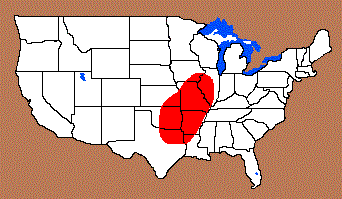
Distribution Comments:
This point is primarily found in the middle Mississippi River Valley and into the Illinois River Valley. This point may be found into eastern Oklahoma and northeastern Texas with decreased frequency.
This point is primarily found in the middle Mississippi River Valley and into the Illinois River Valley. This point may be found into eastern Oklahoma and northeastern Texas with decreased frequency.
Age / Periods:
Date: 1,300 - 600 B.P.
Cultural Period: Mississippian - Prehistoric
Glacial Period: Vandal Minimum to Medieval
Warm
Culture:
Date: 1,300 - 600 B.P.
Cultural Period: Mississippian - Prehistoric
Glacial Period: Vandal Minimum to Medieval
Warm
Culture:
Age Details:
Perino (1971) reports that these points are found in late Woodland sites and are associated with Neosho potsherds.
Perino (1971) reports that these points are found in late Woodland sites and are associated with Neosho potsherds.
Similar Points:
Epps, Gibson, Grand, Helton, Kay Blade, Lundy, Motley, Neosho, Snyders, Steuben, Table Rock
Epps, Gibson, Grand, Helton, Kay Blade, Lundy, Motley, Neosho, Snyders, Steuben, Table Rock
Other points in this cluster / Related / Associated Points:
Neosho
Neosho

